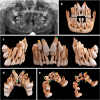Cinematic rendering to improve visualization of supplementary and ectopic teeth using CT datasets
- PMID: 37015249
- PMCID: PMC10170174
- DOI: 10.1259/dmfr.20230058
Cinematic rendering to improve visualization of supplementary and ectopic teeth using CT datasets
Abstract
Objectives: Ectopic, impacted, and supplementary teeth are the number one reason for cross-sectional imaging in pediatric dentistry. The accurate post-processing of acquired data sets is crucial to obtain precise, yet also intuitively understandable three-dimensional (3D) models, which facilitate clinical decision-making and improve treatment outcomes. Cinematic rendering (CR) is anovel visualization technique using physically based volume rendering to create photorealistic images from DICOM data. The aim of the present study was to tailor pre-existing CR reconstruction parameters for use in dental imaging with the example of the diagnostic 3D visualization of ectopic, impacted, and supplementary teeth.
Methods: CR was employed for the volumetric image visualization of midface CT data sets. Predefined reconstruction parameters were specifically modified to visualize the presented dental pathologies, dentulous jaw, and isolated teeth. The 3D spatial relationship of the teeth, as well as their structural relationship with the antagonizing dentition, could immediately be investigated and highlighted by separate, interactive 3D visualization after segmentation through windowing.
Results: To the best of our knowledge, CR has not been implemented for the visualization of supplementary and ectopic teeth segmented from the surrounding bone because the software has not yet provided appropriate customized reconstruction parameters for dental imaging. When employing our new, modified reconstruction parameters, its application presents a fast approach to obtain realistic visualizations of both dental and osseous structures.
Conclusions: CR enables dentists and oral surgeons to gain an improved 3D understanding of anatomical structures, allowing for more intuitive treatment planning and patient communication.
Keywords: 3D visualization; CBCT; CT; dental anatomy; dental radiology; volume rendering.
Conflict of interest statement
Figures





